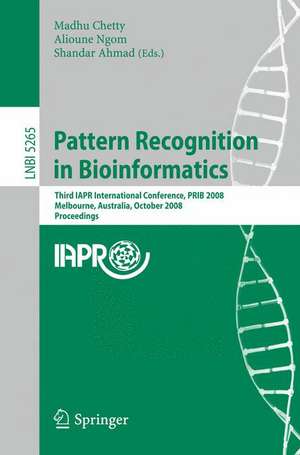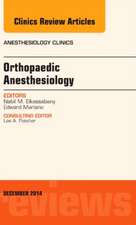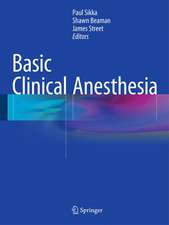Pattern Recognition in Bioinformatics: Third IAPR International Conference, PRIB 2008, Melbourne, Australia, October 15-17, 2008. Proceedings: Lecture Notes in Computer Science, cartea 5265
Editat de Madhu Chetty, Alioune Ngom, Shandar Ahmaden Limba Engleză Paperback – 29 sep 2008
Din seria Lecture Notes in Computer Science
- 20%
 Preț: 1061.55 lei
Preț: 1061.55 lei - 20%
 Preț: 307.71 lei
Preț: 307.71 lei - 20%
 Preț: 438.69 lei
Preț: 438.69 lei - 20%
 Preț: 579.30 lei
Preț: 579.30 lei -
 Preț: 410.88 lei
Preț: 410.88 lei - 17%
 Preț: 427.22 lei
Preț: 427.22 lei - 20%
 Preț: 596.46 lei
Preț: 596.46 lei - 15%
 Preț: 448.04 lei
Preț: 448.04 lei - 20%
 Preț: 353.50 lei
Preț: 353.50 lei -
 Preț: 389.49 lei
Preț: 389.49 lei - 20%
 Preț: 309.90 lei
Preț: 309.90 lei - 20%
 Preț: 645.28 lei
Preț: 645.28 lei - 20%
 Preț: 763.23 lei
Preț: 763.23 lei - 15%
 Preț: 580.46 lei
Preț: 580.46 lei - 20%
 Preț: 310.28 lei
Preț: 310.28 lei - 20%
 Preț: 655.02 lei
Preț: 655.02 lei - 20%
 Preț: 1183.14 lei
Preț: 1183.14 lei - 20%
 Preț: 340.32 lei
Preț: 340.32 lei -
 Preț: 449.57 lei
Preț: 449.57 lei - 20%
 Preț: 591.51 lei
Preț: 591.51 lei - 18%
 Preț: 938.83 lei
Preț: 938.83 lei - 20%
 Preț: 337.00 lei
Preț: 337.00 lei - 20%
 Preț: 649.50 lei
Preț: 649.50 lei - 20%
 Preț: 607.40 lei
Preț: 607.40 lei - 20%
 Preț: 1414.79 lei
Preț: 1414.79 lei - 20%
 Preț: 1024.44 lei
Preț: 1024.44 lei - 20%
 Preț: 583.40 lei
Preț: 583.40 lei - 20%
 Preț: 453.32 lei
Preț: 453.32 lei - 20%
 Preț: 575.49 lei
Preț: 575.49 lei - 20%
 Preț: 1075.26 lei
Preț: 1075.26 lei - 20%
 Preț: 585.88 lei
Preț: 585.88 lei - 20%
 Preț: 825.93 lei
Preț: 825.93 lei - 17%
 Preț: 360.20 lei
Preț: 360.20 lei - 20%
 Preț: 763.23 lei
Preț: 763.23 lei - 20%
 Preț: 340.32 lei
Preț: 340.32 lei - 20%
 Preț: 504.58 lei
Preț: 504.58 lei - 20%
 Preț: 369.13 lei
Preț: 369.13 lei - 20%
 Preț: 580.93 lei
Preț: 580.93 lei - 20%
 Preț: 343.62 lei
Preț: 343.62 lei - 20%
 Preț: 350.21 lei
Preț: 350.21 lei - 20%
 Preț: 583.40 lei
Preț: 583.40 lei - 20%
 Preț: 583.40 lei
Preț: 583.40 lei - 15%
 Preț: 438.59 lei
Preț: 438.59 lei - 20%
 Preț: 341.95 lei
Preț: 341.95 lei - 20%
 Preț: 238.01 lei
Preț: 238.01 lei - 20%
 Preț: 538.30 lei
Preț: 538.30 lei
Preț: 402.17 lei
Nou
Puncte Express: 603
Preț estimativ în valută:
76.97€ • 80.06$ • 63.54£
76.97€ • 80.06$ • 63.54£
Carte tipărită la comandă
Livrare economică 14-28 aprilie
Preluare comenzi: 021 569.72.76
Specificații
ISBN-13: 9783540884347
ISBN-10: 3540884343
Pagini: 472
Ilustrații: XVI, 472 p.
Dimensiuni: 155 x 235 x 30 mm
Greutate: 0.75 kg
Ediția:2008
Editura: Springer Berlin, Heidelberg
Colecția Springer
Seriile Lecture Notes in Computer Science, Lecture Notes in Bioinformatics
Locul publicării:Berlin, Heidelberg, Germany
ISBN-10: 3540884343
Pagini: 472
Ilustrații: XVI, 472 p.
Dimensiuni: 155 x 235 x 30 mm
Greutate: 0.75 kg
Ediția:2008
Editura: Springer Berlin, Heidelberg
Colecția Springer
Seriile Lecture Notes in Computer Science, Lecture Notes in Bioinformatics
Locul publicării:Berlin, Heidelberg, Germany
Public țintă
ResearchCuprins
Protein: Structure, Function, and Interaction.- Sequence Based Prediction of Protein Mutant Stability and Discrimination of Thermophilic Proteins.- A Method to Find Sequentially Separated Motifs in Biological Sequences (SSMBS).- Predicting SUMOylation Sites.- DFS Based Partial Pathways in GA for Protein Structure Prediction.- Evaluation of the Stability of Folding Nucleus upon Mutation.- Prediction of Protein Beta-Sheets: Dynamic Programming versus Grammatical Approach.- Using Multi-scale Glide Zoom Window Feature Extraction Approach to Predict Protein Homo-oligomer Types.- Extraction of Binding Sites in Proteins by Searching for Similar Local Molecular Surfaces.- Learning, Classification, and Clustering.- A Clustering Based Hybrid System for Mass Spectrometry Data Analysis.- A Modified Markov Clustering Approach for Protein Sequence Clustering.- Feature Selection and Classification for Small Gene Sets.- Pseudoknot Identification through Learning TAGRNA.- Support Vector Based T-Score for Gene Ranking.- Prediction of Transcription Factor Families Using DNA Sequence Features.- g-MARS: Protein Classification Using Gapped Markov Chains and Support Vector Machines.- Bio-Molecular Networks and Pathways Analysis.- Domain-Domain Interaction Identification with a Feature Selection Approach.- Dividing Protein Interaction Networks by Growing Orthologous Articulations.- Constraint Minimization for Efficient Modeling of Gene Regulatory Network.- Fusion of Gene Regulatory and Protein Interaction Networks Using Skip-Chain Models.- TopEVM: Using Co-occurrence and Topology Patterns of Enzymes in Metabolic Networks to Construct Phylogenetic Trees.- Generating Synthetic Gene Regulatory Networks.- Microarray and Gene Expression Analysis.- Gene Selection for Microarray Data by a LDA-Based Genetic Algorithm.- Sequential Forward Selection Approach to the Non-unique Oligonucleotide Probe Selection Problem.- On Finding and Interpreting Patterns in Gene Expression Data from Time Course Experiments.- Microarray Design Using the Hilbert–Schmidt Independence Criterion.- Identifying Non-random Patterns from Gene Expression Profiles.- A Study on the Importance of Differential Prioritization in Feature Selection Using Toy Datasets.- Weighted Top Score Pair Method for Gene Selection and Classification.- Data Mining and Knowledge Discovery.- Identifying Conserved Discriminative Motifs.- Exploratory Data Analysis for Investigating GC-MS Biomarkers.- Multi-relational Data Mining for Tetratricopeptide Repeats (TPR)-Like Superfamily Members in Leishmania spp.: Acting-by-Connecting Proteins.- Heuristic Non Parametric Collateral Missing Value Imputation: A Step Towards Robust Post-genomic Knowledge Discovery.- Protein Expression Molecular Pattern Discovery by Nonnegative Principal Component Analysis.- Gene Ontology Assisted Exploratory Microarray Clustering and Its Application to Cancer.- Discovery of Biomarkers for Hexachlorobenzene Toxicity Using Population Based Methods on Gene Expression Data.- Applications of High Performance Computing.- Exploiting Fine-Grained Parallelism in the Phylogenetic Likelihood Function with MPI, Pthreads, and OpenMP: A Performance Study.- Massively Parallelized DNA Motif Search on the Reconfigurable Hardware Platform COPACOBANA.- GPU-MEME: Using Graphics Hardware to Accelerate Motif Finding in DNA Sequences.- Accelerating BLASTP on the Cell Broadband Engine.
Textul de pe ultima copertă
This book constitutes the refereed proceedings of the International Workshop on Pattern Recognition in Bioinformatics, PRIB 2008, held in Melbourne, Australia, in October 2008.
The 39 revised full papers presented were carefully reviewed and selected from 121 submissions. The papers discuss the applications of pattern recognition methods in the field of bioinformatics to solve problems in life sciences. The papers are organized in 6 topical parts on protein: structure, function and interaction; learning, classification and clustering; bio-molecular networks and pathways analysis; microarray and gene expression analysis; data mining and knowledge discovery; applications of high performance computing.
The 39 revised full papers presented were carefully reviewed and selected from 121 submissions. The papers discuss the applications of pattern recognition methods in the field of bioinformatics to solve problems in life sciences. The papers are organized in 6 topical parts on protein: structure, function and interaction; learning, classification and clustering; bio-molecular networks and pathways analysis; microarray and gene expression analysis; data mining and knowledge discovery; applications of high performance computing.








